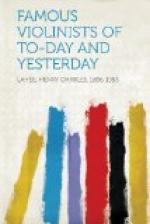Spohr had a great many pupils, of whom the best known were Ries, Ferd. David, Blagrove, Bargheer, Koempel, and Henry Holmes. He was also considered one of the best conductors of his time, and introduced into England the custom of conducting with a baton.
Amongst the amusing episodes in the life of Spohr was one which took place in London, when a servant brought him a letter desiring M. Spohr to “be present at four o’clock to-morrow evening at the closet of the undersigned,” Spohr had not the faintest idea as to the identity of “the undersigned,” nor the least inkling of that gentleman’s design. He therefore replied that he had an engagement at that time. To this note he received another polite epistle asking him to be good enough to honour the “undersigned” with an interview, and to choose his own time. He therefore made an appointment, which he kept punctually, and on arriving at the house to which he was directed, he found an old gentleman, who was very genial, but who could speak neither French nor German. As Spohr spoke no English the communication between them was of necessity carried on by pantomime. The old gentleman led the way into a room, the walls of which were literally covered with violins, from which Spohr gathered the idea that he was to pick out that which he considered the best. After trying them all he had to decide between the merits of half a dozen, and, when he finally gave his opinion, the gentleman seemed delighted, and offered him a five pound note to compensate him for his trouble. This the violinist declined to accept, for he had found as much enjoyment as his host, and considered it a privilege to be able to examine such a fine collection of beautiful instruments. The gentleman found a way of satisfying his ideas of compensation by buying tickets to the value of ten pounds, for one of Spohr’s concerts.
Among the most talented violinists of the early part of the nineteenth century was Karl Joseph Lipinski, the son of a Polish violin player whose gifts were uncultivated. He was born in Poland, in 1790, at a small town named Radzyn. After learning, with the aid of his father, to play the violin, he took up the ’cello, and taught himself to play that instrument, and in later days he attributed his full tone on the violin to the power which his ’cello practice gave to his bow arm.
Lipinski seems to have been an energetic and original man. He was in the habit of appearing at concerts both as violinist and ’cellist. He was unable to play the piano, so when he was conductor of the opera at Lemberg he directed with the violin, and frequently had to play two parts, which gave him great command over his double stops. When the fame of Paganini reached him he set forth to Italy, that he might profit by hearing the great virtuoso, and when the opportunity came at Piacenza, he distinguished himself by being the only person in the audience to applaud the first adagio. After the concert he was introduced to Paganini, and he did not fail to improve the acquaintance, frequently visiting Paganini and playing with him, sometimes even in his concerts.




